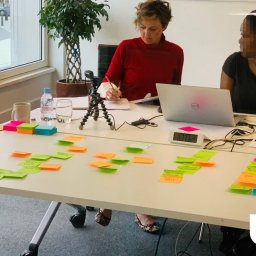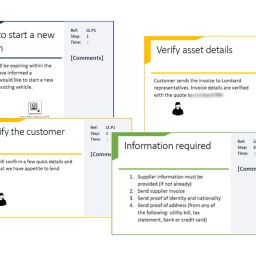
Generative research comes under a whole list of alternative names: discovery research, foundational research, exploratory research, problem-space research, and more.
However you know it, the results are the same: generating information and understanding the fundamental problems of a particular situation. In effect, we’re exploring each case for a bigger picture of the problem, not the solutions we already think we need.
With that, we can make a clean break from evaluative research that conducts validation and UX testing. If you’ve already thought about what technology or solution you could create, you’ve gone too far; you’re already out of the generative discovery phase and into evaluation.
Why is generative design research so important?
Often overlooked by stakeholders, eager to dive into building the product they hope will make them successful, generative research explores whether or not the project is viable—you may end up creating a product that nobody actually needs or isn’t beneficial enough, or profitable—and what it needs to be of use for its various user groups.
Instead of diving into the UX research around a hopeful new problem-solving app, website, platform, or feature, we ask:
What do we know about the problem we’re trying to solve, how big is it, and what else is there to uncover?
It’s like learning as much about an illness as possible, how it affects the people who suffer from it, how they cope, and whether it’s worth developing a particular type of cure before considering what kind of medicine or procedure would offer the best solutions.
Comparing generative research to evaluative research
| Generative research | Evaluative research | |
| Aim |
To uncover the actual problems and determine the value of a project. “What problems do we need to solve?” |
To evaluate solutions within the product. “How are our solutions performing?” |
| Users | Everyone from stakeholders and product users to sales, marketing, and design and development teams. | Most typically, product users. |
| Study | User-centric. | Product-centric. |
| Motivations | External – Who, why, when, where, and how users feel. | Internal – How the product is being used and performing. |
| Data | Observations and discussions into behaviours that uncover new and unseen issues. | Uncovering process pain points to remedy system issues and problems. |
| End result | To determine solution possibilities for previously unseen issues. | Validation of a solution or to enhance the existing product UX. |
| When? | Typically, at the beginning of the product cycle, but also when considering new avenues for existing products. | At product and prototype testing stages. |
When should you use generative research?
Generally, we assume generative research is most prevalent at the beginning of a project to determine whether it’s got value and reason to move forward.
When we look at the UK Design Council Double Diamond model, discovery comes at the beginning of the first diamond. So we’re encouraged to explore our understanding of the problem space before anything else. Once we have, we define an evidence-based problem statement to develop and deliver the solutions in the second diamond.
But that’s not all. It can also help bring teams together when the combined direction or vision isn’t clear and determine problems at more than just the product level.
It’s invaluable in exploring organisation strategies and performance, company mergers and new business acquisitions to examine the effects of regulatory changes or new policy introductions. It’s also the ideal tool to scrutinise internal issues such as inconsistent sales, possible marketing avenues, and other opportunities.
Given its value, it’s surprising how many organisations skip over or fail to engage in such a valuable practice, jumping straight to prototype design and testing.
What should generative research uncover?
Heading back to generative research being user-centric, what we’re looking for is a greater understanding of our users: their behaviours, their problems, needs, and desires, and the value of delivering a solution to their issues.
Once we uncover those problems and the feelings behind them, we can work on the best possible solutions and how those solutions bring value to the user and the stakeholder’s organisation.
Carrying out generative research
If you’re interested in learning how to do generative research for yourself, or engaging with a team to explore an idea or a particular problem, then the following is a simple, stripped-down process split into some common steps.
1. Outline the project background
Even though generative research is designed to uncover unknown issues and problems, heading blindly into any research project is simply research for research’s sake.
So, first, decide why you’re doing the research and what you hope to achieve. It’ll help drive your goals and objectives.
2. Set goals – define the research objectives
Unlike evaluative research, generative data studies don’t have a product, prototype, or idea to test, only a problem to explore.
Setting goals might not always be as straightforward, but examining a possible problem through discussions and brainstorming with staff, stakeholders, and users can uncover valuable information.
What should you explore to make improvements: low engagement, failing to break new markets, uncovering the lifestyle pain points of your users, who your ideal users are?
What objectives can uncover those hidden problems: user motivations, how and when they use your product, how it aligns with their lifestyles and day-to-day complications? Start there, and see what develops.
Another way to consider objectives is to ask yourself what a successful study would achieve and work back from there.
3. Create your research plan
Your plan can be straightforward and simple to create:
- State your objectives
- Decide how you’ll gather participants and how you’ll incentivise them
- List and explain your chosen research methods
- Determine a schedule and timeline for the study
There are plenty of UX tools ideally suited to generative research, for example, field studies, diary studies, user interviews, stakeholder interviews, exploratory analysis, workshops, reviews, focus groups, and more. You’ll have to decide which is most appropriate for your exploration and which will likely uncover those necessary discoveries.
4. Create your research questions
Unlike compiling quantitative data, you’ll ask open-ended questions leading to follow-ups and further follow-ups, uncovering a range of qualitative data.
When carrying out generative user research interviews, you need to keep probing the way a 5-year-old might to get right to the heart of the matter, with a repetitive why, why, why, following every answer; only you need to ensure the conversation isn’t as annoying and flows easily, connecting questions from topic to topic.
Ask participants to walk you through their actions, schedule, and life or to explain what was going on when they last experienced the situation you’re digging into. Don’t be afraid to keep asking about a particular situation until you’ve uncovered everything there is to know and have everything you need from them.
The whole idea is to put yourself in their shoes and understand what they were doing, what they were facing, and how they felt; these are the things that should guide your questions.
5. Carry out the research
With a solid set of questions and objectives and a participant pool ready to go, it’s time for your team to conduct the research.
Follow your plan, don’t be afraid to dig deep, and uncover the user stories to paint a genuine picture of the problem space.
6. Synthesise your findings and document the data
There are many ways to analyse the data; as with most research systems, you’re looking for patterns, reoccurring problems, frustrations, and pain points that will guide you towards making the most effective and necessary moves for your users. You’ll also examine how this new information will affect your client and their operation.
Finally, address what you’ve found and list possible solutions to move the research forward into the next best steps.
7. Present the results to your stakeholders
Once again, this UX process needs more than an emailed document outlining its findings. To ensure stakeholders understand precisely what you’ve learned and the benefits of reacting to this new data, you should conduct a concise and easy-to-digest presentation, outlining the issues, the ideal direction, and why it’s essential for their operation.
Summary
The critical challenge of generative research isn’t in creating the process or the delivery but, more often than not, in getting stakeholders to see the benefits of the results it uncovers.
Taking a step back to see the bigger picture—what the real problems are and how they affect the lives and emotions of their users—uncovers the areas where we can make a real difference. The personal value of those upgrades, improvements, expansions, or new products isn’t something to be taken for granted but welcomed.
And what if your research uncovers nothing more than a product built on hope and false assumptions? Well, just think of the money you’ve saved by not taking it into production.
If you would like to know more about this interesting and potentially extremely useful technique, ring us on +44(0)800 024624 or email us at hello@ux247.com.






